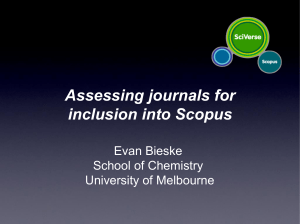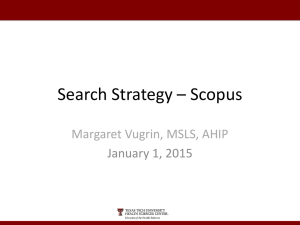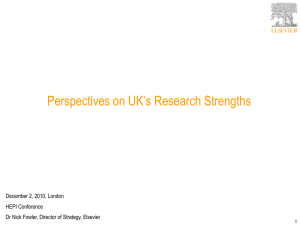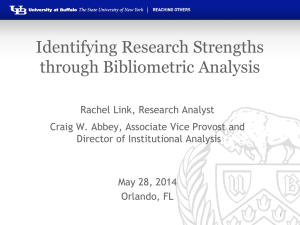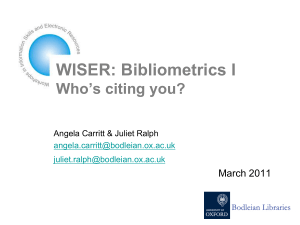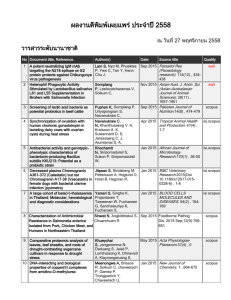Chemogenomic approaches to drug discovery
advertisement
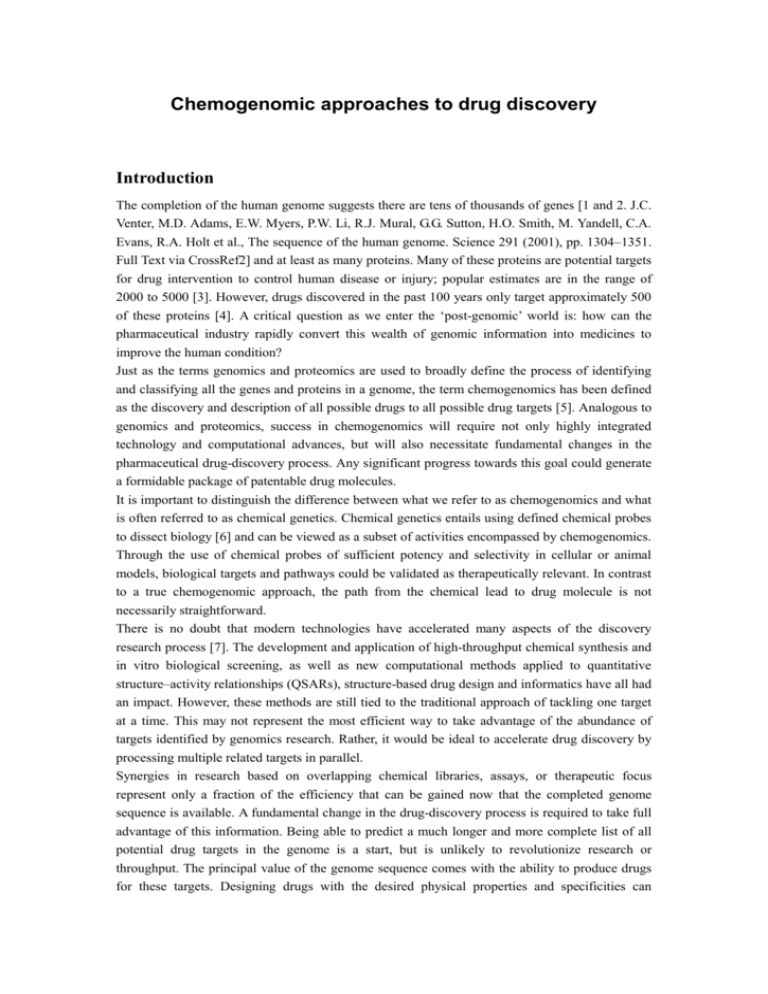
Chemogenomic approaches to drug discovery Introduction The completion of the human genome suggests there are tens of thousands of genes [1 and 2. J.C. Venter, M.D. Adams, E.W. Myers, P.W. Li, R.J. Mural, G.G. Sutton, H.O. Smith, M. Yandell, C.A. Evans, R.A. Holt et al., The sequence of the human genome. Science 291 (2001), pp. 1304–1351. Full Text via CrossRef2] and at least as many proteins. Many of these proteins are potential targets for drug intervention to control human disease or injury; popular estimates are in the range of 2000 to 5000 [3]. However, drugs discovered in the past 100 years only target approximately 500 of these proteins [4]. A critical question as we enter the ‘post-genomic’ world is: how can the pharmaceutical industry rapidly convert this wealth of genomic information into medicines to improve the human condition? Just as the terms genomics and proteomics are used to broadly define the process of identifying and classifying all the genes and proteins in a genome, the term chemogenomics has been defined as the discovery and description of all possible drugs to all possible drug targets [5]. Analogous to genomics and proteomics, success in chemogenomics will require not only highly integrated technology and computational advances, but will also necessitate fundamental changes in the pharmaceutical drug-discovery process. Any significant progress towards this goal could generate a formidable package of patentable drug molecules. It is important to distinguish the difference between what we refer to as chemogenomics and what is often referred to as chemical genetics. Chemical genetics entails using defined chemical probes to dissect biology [6] and can be viewed as a subset of activities encompassed by chemogenomics. Through the use of chemical probes of sufficient potency and selectivity in cellular or animal models, biological targets and pathways could be validated as therapeutically relevant. In contrast to a true chemogenomic approach, the path from the chemical lead to drug molecule is not necessarily straightforward. There is no doubt that modern technologies have accelerated many aspects of the discovery research process [7]. The development and application of high-throughput chemical synthesis and in vitro biological screening, as well as new computational methods applied to quantitative structure–activity relationships (QSARs), structure-based drug design and informatics have all had an impact. However, these methods are still tied to the traditional approach of tackling one target at a time. This may not represent the most efficient way to take advantage of the abundance of targets identified by genomics research. Rather, it would be ideal to accelerate drug discovery by processing multiple related targets in parallel. Synergies in research based on overlapping chemical libraries, assays, or therapeutic focus represent only a fraction of the efficiency that can be gained now that the completed genome sequence is available. A fundamental change in the drug-discovery process is required to take full advantage of this information. Being able to predict a much longer and more complete list of all potential drug targets in the genome is a start, but is unlikely to revolutionize research or throughput. The principal value of the genome sequence comes with the ability to produce drugs for these targets. Designing drugs with the desired physical properties and specificities can become an active process that can be undertaken at the very earliest stages of target selection rather than a process primarily driven by trial and error. Efficiency in gene families The major technological advances in drug discovery in the past decade have led to increases in throughput by parallel processing, miniaturization and robotics. However, significant time and resources are still required to gather and generate reagents, validate the methodologies and develop assays for any novel target. Obviously, one way to gain efficiency is to re-use information and know-how. Targets within a gene family— defined by homology at the protein sequence level—will often have very similar in vitro assays and properties. A significant percentage of compounds designed and synthesized against one family member will be active against other family members, which very often have different biological functions [8]. The reuse of chemistry and biology resources is not only more efficient than starting from scratch each time, but there may be proprietary intellectual property that is transferable among prietary intellectual property that is transferable among related targets. The concept of organizing targets in related gene families is not new, and indeed there are several commentaries in the literature which suggest that, at least conceptually, chemistry efforts can be focused in this way. Frye [9] described the use of structure–activity data from high-throughput screening to empirically identify targets that show similar patterns, and are therefore ‘structure–activity relationship (SAR) homologous’. Thorpe [10] suggested that a family-based screening strategy employing focused libraries provides benefit. Debouck and Metcalf [11] described the approach of determining the functions of all members of gene families that have ‘proven records’ in drug discovery, and then focusing a chemistry effort on the most intriguing targets. Ideal gene families for this approach might include the G-protein-coupled receptors, ion channels, nuclear hormone receptors and proteases. Chemogenomic approaches to drug discovery Systematic classification by gene family provides one way to begin a focused chemogenomic approach to drug discovery. Based on our experience with organizing projects along gene family lines, and by deploying structural biology and modeling approaches along with combinatorial and medicinal chemistry, we have discovered multiple classes of compounds to inhibit multiple targets within a gene family. Because targets within a family are related but not identical, and because the prediction of ADME (absorption, distribution, metabolism, excretion) and other biological properties is still an inexact science, it is advantageous to build many distinct classes of compounds and have diverse compound collections within each compound class. Once created, the molecular libraries may be screened against multiple targets within the family, and frequently new and sometimes unexpected uses will be found for old compounds. Although the gene-family research model may be an efficient way in general to approach drug discovery, it doesn't inherently take advantage of the wealth of information available from genomics. A genome-wide perspective is the key distinction between traditional gene-family research and chemogenomics and represents one of the first true applications employing the vast amount of information in the complete human genome sequence in the pharmaceutical industry. The completed genome sequence enables the identification and classification of all members of a gene family into subfamilies based on a number of criteria: overall sequence homology, domain structure, and/or transcriptional regulation. The dramatic increase in the amount of data from protein structural biology has been obscured by the publicity surrounding the Human Genome Project (Fig. 1). The three-dimensional structures of approximately 15 000 proteins are now publicly available and there has been a recent surge of interest in the public and private sector to actively obtain representative structures for novel proteins. The combination of this raw data and refined homology modeling tools enables the structures of a large number of pharmaceutically relevant protein targets to be predicted as well as the shapes and physical properties of potential ligand-binding sites. The ability to map genomic data onto protein structures provides the framework linking three billion As, Cs, Gs, and Ts to drug-design chemistry. Full-size image (5K) Fig. 1. Database growth. The number of protein structures (solid line) submitted to the Protein Data Bank, although orders of magnitudes lower than the number of sequences deposited to Genbank (dashed line) has been growing rapidly. Sources: http://www.rcsb.org/pdb/holdings_table.html, http://www.ncbi.nlm.nih.gov/Genbank/genbankstats.html. View Within Article Target families versus therapeutic areas A valid criticism of the gene-family approach is that pharmaceutical research is heavily dependent on strong therapeutic area knowledge. Large pharmaceutical companies are traditionally organized along therapeutic area lines on both the commercial and R&D sides of the organization. Although there is a clear rationale for organizing late-stage development (phases II–IV) and commercial operations along therapeutic lines, our experience suggests this organizational structure is sub-optimal for a chemogenomic approach to discovery. In a traditional pharmaceutical organizational structure, research and early development activities are placed into therapeutic area categories. Thus, in the research groups, the primary organizing principle is the biology of certain diseases. This biologic expertise is distributed across buildings, and often these buildings are distributed across countries, and, increasingly, across continents. Medicinal chemistry and chemical libraries are often seen as ‘core functions’ that are overlaid in a horizontal fashion over this infrastructure. This organizational structure is not optimally suited to a chemogenomic approach. A central tenet of the chemogenomic approach is that productivity increases will result from efficient reuse of information and compounds, driven by the overlap between chemical space and the active sites of the protein-family members. Maximal increases in efficiency and productivity can only occur when this knowledge is concentrated in a single discovery unit that is organized along areas of ‘chemogenomic space’. We believe it is possible to have this organizational structure from project initiation through initial human studies, while later-stage development and commercial operations retain the traditional therapeutic area focus. Another distinct advantage of this discovery structure occurs for targets with multiple potential therapeutic indications. Often, the optimal compound characteristics (intravenous versus oral dosing, formulation and specificity) will differ across potential therapeutic indications. During lead optimization, differing compound characteristics across multiple therapeutic indications can be explored fully, whereas in a traditional pharmaceutical organization discovery efforts are usually confined towards only a single therapeutic indication. Genomic data and drug discovery Having a comprehensive catalog of all the members of a given gene family in the human genome allows one to take a very different perspective on the drug-discovery process. The binding site for a given inhibitor can be determined in numerous ways including X-ray crystallography, NMR, and site-directed mutagenesis. The availability of the complete sets of related genes for a given target and a representative subset of protein structures allows one to build three-dimensional models for the entire protein family and to map the interactions of a given substrate or inhibitor and specific residues in the target even when detailed structural data is unavailable. (Obviously structural data is always preferable to building models, and the quality of the models depends on the availability of sufficient structural data.) Having a complete catalog of all related genes and the subset of residues that provide key inhibitor interactions enables the prediction of inhibitor specificity. Inhibitors that target highly conserved sidechains or protein-backbone atoms are much more likely to be non-specific. Conversely, inhibitors which make strong interactions with residues that are non-conserved are likely to demonstrate more target specificity. We and others have demonstrated that single amino-acid changes are sufficient to generate specificity in protein kinases [12, 13, 14 and 15]. Knowing the detailed receptor–ligand interactions within a binding pocket allows predictions of the relatedness of various targets for broad panels of inhibitors. Experience has shown that although some specificity is possible between two targets in which the inhibitor-binding pockets are lined with identical residues, this is seldom more than 10-fold. Presumably, the limited specificity seen is a result of conformational changes that lead to subtle differences in the shape of the inhibitor-binding site. Examples of this can be extracted from analysis of the HIV-protease-resistant mutations—several of which have been solved crystallographically [16 and 17]. A prediction of the lack of specificity for a given inhibitor suggests that this inhibitor may provide a good lead for a novel target. The genomic data can then be used to focus inhibitor design towards areas of the novel target molecule that enable engineering of specificity. To take full advantage of this type of analysis, a complete list of protein family members is essential. The specificity prediction at the target level can be applied to the target selection process. Knowing the number and composition of the subset of targets that are related in the inhibitor-binding site is essential in the evaluation of how the proposed clinical indication correlates with the potential alternate target list. Having this type of analysis for complete biological pathways would allow one to use the specificity prediction to help choose the most appropriate target in the pathway. Gene-family mapping Traditional bioinformatics focuses on clustering targets based on sequence homology. Because our principal interest is in designing selective drugs against many targets from the same family, we cluster targets based on homologies within the active site itself. The specific algorithms can vary as a function of compound class (because different compounds engage different regions of the active site), or based on different properties within the active site (e.g. lipophilicity, volume, protein structural reorganization, tightly bound water molecules, or the presence or absence of specific amino acids). The classification gets refined as more information becomes available from screening and structural biology. The availability of the complete sets of related genes for a given target and a representative subset of protein structures allows one to build three-dimensional models for the entire protein family. The models can be used to predict physical properties of the ligand-binding sites on individual gene products or to make broader observations on a set of targets. For example, in Fig. 2 the protein surface has been colored by predicted physical property conservation where green patches depict regions of the protein surface that are predicted to have similar properties among many homologs. It is apparent at the atomic level of the inhibitor that modifications at certain positions are more likely to lead to interactions with increased specificity for the target than others. This coupled with the traditional insights obtained from a focused structure-based drug-design effort proves to be an extremely powerful tool. Full-size image (45K) Fig. 2. Surface representation of the co-complex structure of a pyridinylimidazole inhibitor and p38 MAP kinase [12] colored by conserved physical properties. Maps of these features to the three-dimensional surface can be used to guide inhibitor design at atomic level detail. View Within Article Chemogenomics through mutagenesis The ability to confidently assign most of the inhibitor-binding potency and specificity to a small set of amino acids allows one to easily genetically modify one protein target such that the overall physical properties of the target, including protein expression, purification protocols, assays and crystallographic behavior, are maintained, but the inhibitor profile mimics a novel target. Simply put, certain proteins are harder to work with than others. Through directed mutagenesis of residues surrounding the inhibitor-binding site in a well-characterized homolog, a hybrid protein can be created that behaves very similarly to the template at the gross biochemical level, but resembles the novel protein at the ligand-binding site [14]. In many cases, control experiments show that the binding affinity of ligands to the hybrid protein is quite close to that of the wild type system and the hybrid system can thus be used as a surrogate for the target of interest to direct a drug effort. Three-dimensional structural determination of the hybrid target, either alone or in complex with inhibitors, can be used as a further basis for design of novel compound classes. It is with these types of approaches that the full potential of chemogenomics may be realized. The transferability of the inhibitor-binding profile to a well-studied target facilitates the rapid generation of experimental data that can be used to not only jump start work on a novel target, but can also be used to extrapolate to a much broader set of virtual protein targets. Chemogenomics in the absence of structure? The ability to map protein sequence onto inhibitor–target co-complex structures has thus far been a fundamental link between the genomic sequence information and the medicinal chemistry required for drug design. As the number of protein structures that are available increases, the lack of protein structure should become less of a limitation. Indeed, the recent publication of the structure of a mammalian GPCR and the increasing number of publications on membrane-bound proteins are testaments to this [18, 19 and 20]. However, there is no strict requirement for high-resolution structural data to effectively employ the chemogenomics strategy. At the amino-acid level, it is possible to utilize various protein-folding prediction methods and mutagenesis data to build respectable models of most proteins. These models would be sufficient to provide chemistry direction and predict potential compound specificity. Chemogenomic examples An example of a broad family of enzymes, many of which are attractive drug targets because of their roles in signal transduction, are the protein kinases. Roughly 500 serine/threonine and tyrosine protein kinases have homologous sequences. This sequence homology is also evident in the structural similarity of proteins within the protein kinase family. Inhibitors such as staurosporine are active against both serine/threonine and tyrosine kinases and can serve as a starting point for discovery of highly specific inhibitors [21 and 22]. Relatively simple modifications of staurosporine have been shown to increase specificity consistent with predictions from homology modeling of cross-reacting kinases [23]. Recent interest in the mitogen-activated protein (MAP) kinases have led to the discovery of multiple parallel protein kinase cascades comprised of proteins of related sequences [24]. Not only do each of these pathways provide multiple sites of potential intervention, but high sequence homology between members of different pathways suggests that it would be relatively easy to transfer knowledge gained from one target to another. Although high sequence similarity may pose a problem for specificity, inhibitors have been developed in which there is 1000-fold selectivity between enzymes with 50% sequence identity. The precise position of the inhibitor in the enzyme structure indicates that this is largely because of differences in a single amino-acid residue [14]. The structure also suggests specific modifications to this inhibitor that would be predicted to increase or decrease binding to other related enzymes. The location of these enzymes in parallel signal transduction pathways suggests that although their precise functions may not be known, one or more of them are likely to be drug targets. Another example of an interesting gene family is the caspases, which are cysteine proteases with specificity for cleavage after aspartyl residues. Interleukin-1β converting enzyme (ICE) has been shown to be essential for cytokine processing and is currently being pursued as a drug target [25]. There are also roughly a dozen caspases with sequence homology to ICE, and although the exact function of all of these is not known, it is clear that some of these have an important role in regulation of apoptosis [26]. Structural insights through X-ray crystallography facilitated the rapid identification of selective inhibitors of these other potential drug targets. Experience with ICE has also been applied to the other caspase-family members in the areas of expression, purification, assay development, crystallization, and structure determination [27]. Technology issues A key issue for chemogenomics is how best to generate and utilize information to guide drug design across such a broad landscape of targets. Library design to support a broad gene family effort can benefit from an understanding of the properties of molecules that are more likely to be ‘drug-like’ [28, 29, 30, 31, 32, 33 and 34]. Library design can also benefit from docking ‘virtual libraries’ into crystal structures [35 and 36]. Structural information can help modelers and chemists understand subtle differences between protein target structures, which in turn enable more precise design of chemical libraries. Crystallography can provide both structural information about multiple targets in the gene family, as well as details of the bound conformation of multiple inhibitors to each target. Both kinds of information are of high value [35]. NMR screening technologies such as shapes can be used to detect binding of diverse soluble, drug-like, prototype molecules to a potential drug target. The NMR experiments can be applied to targets with no limitation on molecular weight and no requirement for isotope labeling. The shapes library can be used to identify weakly binding hits (Kd in the micromolar to milimolar range) that might be missed by standard enzymatic assays. These weak binders can then be used as the basis for pharmacophore hypothesis generation, combinatorial library design, virtual screening, database searches, and to bias the selection of compounds for high-throughput screening [37 and 38]. Within a gene family it makes sense to assay ligands against as large and diverse a selection of targets as possible. This builds an internally consistent knowledge base to help understand fully the molecular basis of ligand specificity. It makes more sense to test fewer compounds against more targets, with the compounds and targets both carefully chosen for biological diversity and therapeutic impact. Such an information-rich dataset gives the experimental foundation for mapping chemical space onto biological target space in a given gene family. Data quality is a key determinant for the accuracy of the conclusions based upon this data matrix. Libraries of drug-like compounds that explore space and functionality around a set of pharmacophores for the active site of the target gene family can be synthesized. Sources of pharmacophores are leads generated from quantitative screening assays and analysis of active site crystal structures and homology models. The library diversity around a particular pharmacophore reflects both the scope of the enabling chemistry and information from modeling and structural biology. Generally, the lead compounds come from libraries that have good cell permeability and pharmacokinetic properties. Ideally, development candidates will have previously been generated from other compounds within the same chemical classes. Because of the high quality of the lead compounds and the prior experience working with similar compounds, the time and effort required to produce development candidates is greatly reduced. Bottlenecks in chemogenomics One of the potential advantages of a chemogenomics approach is the breadth of therapeutic areas that can be addressed starting from a single gene family. However, the experimental expertise on the underlying biology as well as the clinical and marketing expertise may be lacking. Although it is possible to quickly generate active molecules against many different targets without sufficient therapeutic area expertise (e.g. biology, clinical, marketing), it would be challenging to steer research into the proper directions and to evaluate these results fairly. A larger problem for the chemogenomics approach is that most of the genes in a gene family have no data linking them to any therapeutic application. The shortage of target validation data may, in principle, be addressed by many different methods including broad panels of gene knockouts, dominant negative mutants, antisense, expression profiling, and proteomics. However, such fundamental biological research is slow and often leads to incomplete understanding. For these reasons, potent and specific inhibitors arising from a chemogenomics effort are potentially the most valuable resources for validating novel targets. These chemical reagents can be used in cellular experiments and in various animal models. A positive result in these experiments would not only give credence to the relevance of a particular target to an important biological process, but would also provide an excellent chemical lead for further optimization. Measures of success Recent advances in technology such as combinatorial chemistry and high-throughput screening have made certain aspects of the drug-discovery process more efficient, but have not had a major impact on overall output. The success of a chemogenomics approach should be quantifiable using a number of parameters—for example, the number of patents, the number of compounds synthesized per clinical candidate and, ultimately, increased numbers of approved drugs and sales. It is expected that patent applications generated with a chemogenomic background would be able to support claims that cover a broader range of chemical space than average and would be able to include a comprehensive list of defined molecular targets and indications. Increased efficiency in identifying potent chemical leads with ‘drug-like’ properties should accelerate the process of driving these leads into clinical development candidates with the desired pharmacologic and pharmacokinetic parameters without compromising quality. As the first of the candidate molecules generated using this integrated approach enter the clinic in the near future, the ability of chemogenomics to increase overall productivity in the pharmaceutical industry will start to be apparent in the number of new molecular entities approved by the US Food and Drug Administration within five years. Conclusions The real power of having the completed human genome sequence lies with the ability to use this information to develop novel therapeutics. The chemogenomics approach, in which this sequence information is combined with protein structure and/or models to link to chemical inhibitors, is designed to fully utilize the sequence information by considering large families of gene targets at once. This highly parallel approach depends on well-established methods such as combinatorial chemistry, high-throughput screening, computational chemistry, structural biology, and bioinformatics, all of which drive the efficient re-use of information, reagents, methods, and know-how as research teams move from one group of targets to the next. In contrast, the traditional ‘single target at a time’ model of drug discovery does not give full leverage to the revolution in high-throughput technologies from the past decade. We note that it is still an open question whether a gene family focus is more efficient than a ‘traditional’ approach, and the details of how best to organize a chemogenomics effort are still being worked out. However, early results from our research into the protein kinases and the caspases support our opinion that a gene family approach can provide a more efficient process for generating late-stage development candidates. Clinical and marketing expertise in specific therapeutic areas is also of great importance to the success of any new drug, and traditionally pharmaceutical companies have organized their R&D efforts to capture the advantages of this expertise. It is essential that gene family initiatives fully utilize such specialized knowledge in particular therapeutic areas while not limiting the pursuit of targets in other therapeutic areas. These particular challenges, although complex, are not insurmountable with foresight and skillful planning. ‘Basic biology’ remains of critical importance in the gene-family paradigm. Indeed, with a much greater number of potential targets, about each of which less is known, the importance of target validation has, arguably, increased. It could be argued that the failure of high-throughput chemical and screening methods in the 1990s to increase pharmaceutical R&D productivity is in part because ‘basic biology’ did not keep pace [39]. The chemogenomic approach clearly shifts the bottleneck in drug discovery to the target-validation area, but also provides reagents that, if properly designed, can help alleviate this new challenge by taking advantage of the availability of compounds as biochemical probes to dissect the role of novel targets, at least at the cellular level, or preferably at the level of animal-disease models. This can provide a huge time advantage because the compounds are ‘off the shelf’ or at least available much more quickly than has traditionally been the case. This validation of targets through chemistry remains another opportunity of the chemogenomic approach that we feel will facilitate the exploration of the function of hereto forth completely uncharacterized genes in the genome. References and recommended reading Papers of particular interest, published within the annual period of review,have been highlighted as: • of special interest •• of outstanding interest References 1. E.S. Lander, L.M. Linton, B. Birren, C. Nusbaum, M.C. Zody, J. Baldwin, K. Devon, K. Dewar, M. Doyle, W. FitzHugh et al., Initial sequencing and analysis of the human genome. Nature 409 (2001), pp. 860–921. Full Text via CrossRef | View Record in Scopus | Cited By in Scopus (8604) 2. J.C. Venter, M.D. Adams, E.W. Myers, P.W. Li, R.J. Mural, G.G. Sutton, H.O. Smith, M. Yandell, C.A. Evans, R.A. Holt et al., The sequence of the human genome. Science 291 (2001), pp. 1304–1351. Full Text via CrossRef 3. J. Drews In: J. Drews and S. Ryser, Editors, Human Disease — from Genetic Causes to Biochemical Effects, Blackwell, Berlin (1997), pp. 5–9. 4. J. Drews and S. Ryser , The role of innovation in drug development. Nat Biotechnol 15 (1997), pp. 1318–1319. Full Text via CrossRef | View Record in Scopus | Cited By in Scopus (83) 5. Incyte and Vertex Enter Genomic Partnership to Accelerate Drug Discovery in Multi-target Gene Families Using LifeSeq Gold on World Wide Web URL: http://www.vpharm.com/Pressreleases2000/pr022900.html. 6. S.L. Schreiber , Chemical genetics resulting from a passion for synthetic organic chemistry. Bioorg Med Chem 6 (1998), pp. 1127–1152. Article | PDF (3335 K) | View Record in Scopus | Cited By in Scopus (263) 7. E.H. Ohlstein, R.R. Ruffolo and J.D. Elliott , Drug discovery in the next millennium. Annu Rev Pharmacol Toxicol 40 (2000), pp. 177–191. Full Text via CrossRef | View Record in Scopus | Cited By in Scopus (66) 8. J. Lehman, A. Baxter, D. Brown, P. Connolly, M. Geysin, M. Hayes, R. Howard, J. Knowles, M. Lee, A. Lyall et al., Systematization of Research. Nature 384 Supp 7 (1996), p. 5. 9. S.V. Frye , Structure-activity relationship homology (SARAH): a conceptual framework for drug discovery in the genomic era. Chem Biol 6 (1999), pp. R3–R7. Abstract | PDF (469 K) | View Record in Scopus | Cited By in Scopus (69) 10. D.S. Thorpe , Forecasting roles of combinatorial chemistry in the age of genomically derived drug discovery targets. Comb Chem High Throughput Screen 3 (2000), pp. 421–436. View Record in Scopus | Cited By in Scopus (12) 11. C. Debouck and B. Metcalf , The impact of genomics on drug discovery. Annu Rev Pharmacol Toxicol 40 (2000), pp. 193–207. 12. K.P. Wilson, P.G. McCaffrey, K. Hsiao, S. Pazhanisamy, V. Galullo, G.W. Bemis, M.J. Fitzgibbon, P.R. Caron, M.A. Murcko and M.S. Su , The structural basis for the specificity of pyridinylimidazole inhibitors of p38 MAP kinase. Chem Biol 4 (1997), pp. 423–431. Article | PDF (5246 K) | View Record in Scopus | Cited By in Scopus (228) 13. J. Lisnock, A. Tebben, B. Frantz, E.A. O'Neill, G. Croft, S.J. O'Keefe, B. Li, C. Hacker, S. de Laszlo, A. Smith et al., Molecular basis for p38 protein kinase inhibitor specificity. Biochemistry 37 (1998), pp. 16573–16581. Full Text via CrossRef | View Record in Scopus | Cited By in Scopus (86) 14. T. Fox, J.T. Coll, X. Xie, P.J. Ford, U.A. Germann, M.D. Porter, S. Pazhanisamy, M.A. Fleming, V. Galullo, M.S. Su et al., A single amino acid substitution makes ERK2 susceptible to pyridinyl imidazole inhibitors of p38 MAP kinase. Protein Sci 7 (1998), pp. 2249–2255. Full Text via CrossRef | View Record in Scopus | Cited By in Scopus (87) 15. R.J. Gum, M.M. McLaughlin, S. Kumar, Z. Wang, M.J. Bower, J.C. Lee, J.L. Adams, G.P. Livi, E.J. Goldsmith and P.R. Young , Acquisition of sensitivity of stress-activated protein kinases to the p38 inhibitor, SB 203580, by alteration of one or more amino acids within the ATP binding pocket. J Biol Chem 273 (1998), pp. 15605–15610. Full Text via CrossRef | View Record in Scopus | Cited By in Scopus (168) 16. B. Mahalingam, J.M. Louis, J. Hung, R.W. Harrison and I.T. Weber , Structural implications of drug-resistant mutants of HIV-1 protease: high-resolution crystal structures of the mutant protease/substrate analogue complexes. Proteins 43 (2001), pp. 455–464. Full Text via CrossRef | View Record in Scopus | Cited By in Scopus (62) 17. L. Hong, X.C. Zhang, J.A. Hartsuck and J. Tang , Crystal structure of an in vivo HIV-1 protease mutant in complex with saquinavir: insights into the mechanisms of drug resistance. Protein Sci 9 (2000), pp. 1898–1904. Full Text via CrossRef | View Record in Scopus | Cited By in Scopus (61) 18. D.A. Doyle, J. Morais Cabral, R.A. Pfuetzner, A. Kuo, J.M. Gulbis, S.L. Cohen, B.T. Chait and R. MacKinnon , The structure of the potassium channel: molecular basis of K+ conduction and selectivity. Science 280 (1998), pp. 69–77. Full Text via CrossRef | View Record in Scopus | Cited By in Scopus (3511) 19. K. Palczewski, T. Kumasaka, T. Hori, C.A. Behnke, H. Motoshima, B.A. Fox, I. Le Trong, D.C. Teller, T. Okada, R.E. Stenkamp et al., Crystal structure of rhodopsin: a G protein-coupled receptor. Science 289 (2000), pp. 739–745. Full Text via CrossRef | View Record in Scopus | Cited By in Scopus (3033) 20. S. Sukharev, M. Betanzos, C.S. Chiang and H.R. Guy , The gating mechanism of the large mechanosensitive channel MscL. Nature 409 (2001), pp. 720–724. Full Text via CrossRef | View Record in Scopus | Cited By in Scopus (179) 21. C. Garcia-Echeverria, P. Traxler and D.B. Evans , ATP site-directed competitive and irreversible inhibitors of protein kinases. Med Res Rev 20 (2000), pp. 28–57. View Record in Scopus | Cited By in Scopus (111) 22. P. Cohen , The development and therapeutic potential of protein kinase inhibitors. Curr Opin Chem Biol 3 (1999), pp. 459–465. Abstract | PDF (820 K) | View Record in Scopus | Cited By in Scopus (121) 23. M.B. Lamers, A.A. Antson, R.E. Hubbard, R.K. Scott and D.H. Williams , Structure of the protein tyrosine kinase domain of C-terminal Src kinase (CSK) in complex with staurosporine. J Mol Biol 285 (1999), pp. 713–725. Article | PDF (824 K) | View Record in Scopus | Cited By in Scopus (104) 24. R. Treisman , Regulation of transcription by MAP kinase cascades. Curr Opin Cell Biol 8 (1996), pp. 205–215. Abstract | PDF (1366 K) | View Record in Scopus | Cited By in Scopus (993) 25. C.A. Dinarello , Interleukin-1 beta, interleukin-18, and the interleukin-1 beta converting enzyme. Ann New York Acad Sci 856 (1998), pp. 1–11. Full Text via CrossRef | View Record in Scopus | Cited By in Scopus (233) 26. N. Marks and M.J. Berg , Recent advances on neuronal caspases in development and neurodegeneration. Neurochem Int 35 (1999), pp. 195–220. Article | PDF (429 K) | View Record in Scopus | Cited By in Scopus (79) 27. Y. Wei, T. Fox, S.P. Chambers, J. Sintchak, J.T. Coll, J.M. Golec, L. Swenson, K.P. Wilson and P.S. Charifson , The structures of caspases-1, -3, -7 and -8 reveal the basis for substrate and inhibitor selectivity. Chem Biol 7 (2000), pp. 423–432. Article | PDF (519 K) | View Record in Scopus | Cited By in Scopus (124) 28. C.A. Lipinski, F. Lombardo, B.W. Dominy and P.J. Feeney , Experimental and computational approaches to estimate solubility and permeability in drug discovery and development settings. Adv Drug Deliv Rev 23 (1997), pp. 3–25. Article | PDF (2455 K) | View Record in Scopus | Cited By in Scopus (2363) 29. W.P. Walters, M.T. Stahl and M.A. Murcko , Virtual screening: an overview. Drug Discov Today 3 (1998), pp. 160–178. Article | PDF (352 K) 30. W.P. Walters and M.A. Murcko, Editors, Library Filtering Systems and Prediction of Drug-Like Properties, Wiley-VCH, Weinheim (2000). 31. A. Ajay, W.P. Walters and M.A. Murcko , Can we learn to distinguish between ‘drug-like’ and ‘nondrug-like’ molecules?. J Med Chem 41 (1998), pp. 3314–3324. Full Text via CrossRef | View Record in Scopus | Cited By in Scopus (315) 32. Ajay, G.W. Bemis and M.A. Murcko , Designing libraries with CNS activity. J Med Chem 42 (1999), pp. 4942–4951. Full Text via CrossRef | View Record in Scopus | Cited By in Scopus (117) 33. G.W. Bemis and M.A. Murcko , The properties of known drugs. 1. Molecular frameworks. J Med Chem 39 (1996), pp. 2887–2893. Full Text via CrossRef | View Record in Scopus | Cited By in Scopus (418) 34. G.W. Bemis and M.A. Murcko , Properties of known drugs. 2. Side chains. J Med Chem 42 (1999), pp. 5095–5099. Full Text via CrossRef | View Record in Scopus | Cited By in Scopus (132) 35. M.A. Murcko, P.R. Caron and P.S. Charifson , Structure-based drug design. Ann Rep Med Chem 34 (1999), pp. 297–306. Abstract | PDF (809 K) | View Record in Scopus | Cited By in Scopus (24) 36. P.S. Charifson, J.J. Corkery, M.A. Murcko and W.P. Walters , Consensus scoring: a method for obtaining improved hit rates from docking databases of three-dimensional structures into proteins. J Med Chem 42 (1999), pp. 5100–5109. Full Text via CrossRef | View Record in Scopus | Cited By in Scopus (355) 37. J. Fejzo, C.A. Lepre, J.W. Peng, G.W. Bemis, Ajay, M.A. Murcko and J.M. Moore , The SHAPES strategy: an NMR-based approach for lead generation in drug discovery. Chem Biol 6 (1999), pp. 755–769. Abstract | PDF (196 K) | View Record in Scopus | Cited By in Scopus (179) 38. J.W. Peng, C.A. Lepre, J. Fejzo, N. Abdul-Manan and J.M. Moore , NMR-based approaches for lead generation in drug discovery. Methods Enzymol 338 (2001), pp. 202–230. 39. J. Drews , Drug discovery: a historical perspective. Science 287 (2000), pp. 1960–1964. Full Text via CrossRef | View Record in Scopus | Cited By in Scopus (947)
